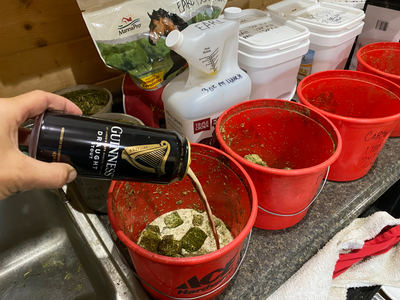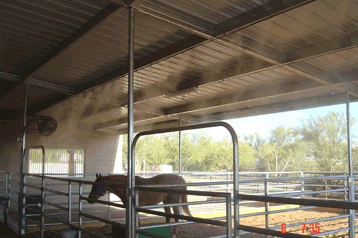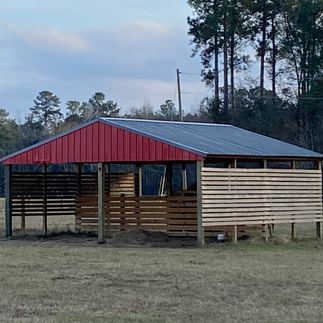BEAT THE HEAT
- stacylpearsall

- Jul 25, 2023
- 8 min read
By Stacy Pearsall (EBRA V0003)

As the heat rises, so too do the chances of heat related equine emergencies. As a resident of South Carolina, where summer temps rise into the 100's with an average humidity of >77%, I'm well accustomed to the various heat threats and how to combat them. Since I receive a lot of messages regarding heat-related questions, I figured I'd share them here. I'd like to remind everyone that I'm not a vet. Much of what I've learned, and am about to share, was taught to me by vets, other experienced hot-state-horseman and my own tried-and-true methods. If you have any questions, concerns, or doubts about the wellness of your horse, please call your vet right away!

Knowing the heat index, or "feels like" temperature, which is a crazy formula that involves the temperature and relative humidity, is important. I often reference the National Weather Service (NWS) chart above, which I keep saved on my smart phone for quick reference. As I write this, it's 10:30 a.m. and already 78 degrees and rising with a humidity of 85%. My phone's Weather Channel app says it's going to be a high of 91 degrees today. Based on the NWS chart, we're already climbing into the "extreme caution" zone and will certainly achieve "danger" status by lunchtime.
Here's my Summer routine. Whether hot or not, I always soak my feed. This helps keep my horses hydrated year-round and reduces the likelihood of choke. In addition to feeding a balanced diet, I have trace mineral and salt blocks scattered around the barn, loafing sheds and pastures.
Fact: A horse can lose 8-12oz of salt per day with moderate to heavy sweating. A horse in moderate exercise will lose 6.8-9 quarts of sweat and may require about 2oz of electrolytes per hour. You should supply your horse with 2-3oz of salt on a daily basis to encourage adequate water consumption and help maintain electrolyte balance, says Richard G. Godbee, Ph.D., PAS, Dipl. ACAS-Nutrition
When it's a Caution or Extreme Caution day, I add a lunchtime forage cube tea that consists of six alfalfa cubes in 3-4 quarts of water (soaked and soupy) with a 1/4 teaspoon (6 teaspoons per ounce) of salt added to encourage additional water drinking. As they're having their cube-teas, I give them all a midday hose down. During Danger or Extreme Danger days, I add a Guinness beer at breakfast and lunch to help support their bodies against heat stress and also up cube teas to three times per day.
All of my horses have access to grass. Most grass pastures are approximately 60–80% moisture, which provides my horses a decent amount of water while grazing. In contrast, grains and baled hay contain far less moisture, which means horses need to drink more to meet their water needs - hence another reason why I always soak my feed.
Fact: Guinness is made from yeast (Saccharomyces cervisiae —strains of which are often found as probiotics in feed and supplements). Yeast provides much of the B-vitamin complex, an important nutritional component in helping horses recover from stress, and provides important probiotic support. Because beer has its foundation in grains such as barley, these convey a flavor that horses often find attractive. As to getting drunk, horses have large amounts of alcohol dehydrogenase enzyme in their livers to process the by-products of microbial fermentation and therefore are surprisingly capable of metabolizing the alcohol present in beer.
During the summer, I work and train my horses during dawn and dusk hours, always offering fresh, cool water throughout our sessions. Danger and Extreme Danger days offer little respite from the heat, even during the dawn and dusk hours. Given the coolest time of daylight hours is in the morning, I transition all my horse work to mornings only. For instance, it was a tolerable 68 degrees this morning, so I trained horses from 6:30-8:30 a.m. and was done before the temps hit 80 degrees.
My horses who are working or training get trace clipped, which is a very minimal clip that just shaves the hair from underneath the throat latch and neck, and a little bit of the chest and under the belly. It helps a horse cool down if it’s still getting sweaty in really cold temperatures or is in light work. The horse still has most of its coat to reduce direct sun exposure to the skin, but there’s a bit of an air channel to help it cool down.
I do not work horses during full-sun hours on Danger or Extreme Danger days. Here's why. Horses normally cool themselves by sweating. The sweat evaporates from the skin surface and causes a cooling effect. Less sweat evaporates during times of high humidity. A horse that is working hard in a hot environment can lose 2 to 4 gallons of sweat per hour - even more for draft horses. As heat and humidity increases, so too does their ability to cool themselves. See the chart below.

FACT: Heat is lost due to evaporative cooling. Heat is also lost by conduction. Hosing your hot horse down with cold water doesn’t cause any ill effects. The colder the water, the more conduction heat loss occurs.

A horse’s normal body temp is between 98.5 to 101 degrees Fahrenheit. I monitor my herd by taking rectal temps on hot days. After all, extreme temperatures can damage a horse's brain and organs. Helping them get rid of that heat, whether through evaporative or conductive cooling, is essential.
Normal breathing rates for adult horses is 8-18 breaths per minute. On Danger and Extreme Danger days, it's not uncommon to see my horses standing stock still, panting. I give cold water hose downs 3 times, sometimes four times per day as needed. I have the luxury of working from home, so popping out to the barn to hose my horses is doable. For those who can't get out to the barn during work hours, you can always set up a tripod sprinkler system or misting system set on a timer.
Shade is essential. All of my horses have access to shade, whether provided by trees, shade sails, loafing sheds or barn run-ins. All of these structures are designed for maximum air flow with high roofs and open or slatted sides. My big barn has power with large fans moving air during the scorching days. I'm presently working to get power to my loafing sheds so we can run fans there too. In the meantime, I prioritize who needs additional supportive care and bring those horses into the barn-access pastures.
For instance, one of my horses has anhidrosis (AN-hih-DROH-sis), so I keep her under the fan. Since foals are heat sensitive, they too have access to fans.
If one of my horses has temp of 102 or above, I'll take immediate, aggressive action. I add a bottle of rubbing alcohol to a bucket of ice water, which I then sponge over the horse's back and neck. The ice cold alcohol-water mix promotes evaporative cooling - just be careful to keep it away from the horse's eyes. I then put them under the fan while I check for signs of dehydration. First I pinch test the skin to see how quickly, or slowly, it recovers. If the pinched skin stays tented for four seconds or longer, I know they need fluids stat. Second, I'll check their gums. If they're tacky, that's yet another sign of dehydration. To get them back on course, I mix a five gallon bucket of prepackaged electrolytes. CLICK HERE to see the top ten equine electrolytes on the market. Another trick I use to encourage hydration is two quartered apples in a five gallon bucket of water and the other is soupy cube teas. If they refuse to drink or eat soupy cube teas, I call my vet as they may need IV fluids.
Fact: Some people give their horses Gatorade thinking it will help. However, horses' sweat consists of 10 times the potassium that is found in human sweat and 3 times the sodium and chloride levels. That's why Gatorade is helpful to humans, but perhaps not so much to horses.
Electrolyte-Replacement Checklist by Eleanor M. Kellon, VMD
Your horse loses electrolytes along with water as they sweat. Their cells function like small batteries with different concentrations of electrolytes inside versus outside the cell. There are even differences in concentrations between the structures inside the cells. Another function of electrolytes, especially sodium, is to “hold” water in your horse’s body. To maintain proper hydration levels, their brain constantly monitors sodium concentration. Thirst is triggered if the concentration of sodium gets too high; salt hunger is triggered if sodium gets too low. There’s a place for electrolyte supplements, but they have to be used correctly. Use this checklist to get started.
Use plain salt to meet your horse’s baseline sodium and chloride needs. Give them 1 ounce (6 teaspoons) per day in winter, 2 ounces (12 teaspoons) per day in summer.
Note: You must factor in all sources of salt in your horse's diet, from feed and supplements, before adding loose salt.
If your horse is working two hours or less at low sweating rates, or one hour or less at moderate sweating rates, add 1 extra ounce of salt for each hour of low sweating work, 2 ounces for each hour of moderate sweating.
If your horse is working longer than the times above, feed the extra salt only to meet the needs of the first two hours (or the one hour of moderate sweating), then use an electrolyte replacement for any additional work above that level.
Give your horse as much water as they want, as often as they want it.
I have 100 gallon water tanks in all my pastures, which I check morning and night. I do not use auto fillers for the expressed purpose of monitoring water consumption. If I notice the water line hasn't moved, I will skin pinch my horses to see if they're dehydrated and once again take steps to get them drinking.
We get algae and moss growth pretty quick in South Carolina, so I clean debris from my water troughs every morning with a pool skimmer and then dump and scrub them every Sunday. I pressure wash them quarterly to remove the tenacious algae growth. This routine ensures my horses have access to clean water at all times.
Fact: The average size horse drinks 10 to 12 gallons of water per day. However, draft horses may drink up to 15 to 20 gallons of water a day. A lactating mare or a horse that has sweated a lot will drink more.
Even with all these preventive measures in place, the old proverb, "you can lead a horse to water, but you can't make it drink," still applies and horse can colic and go down from a dehydration induced impaction. I know my horses' personalities and can easily spot when something is off. As you know, draft horses are stoic animals and often require an eagle eye to notice subtle changes. Here are a few signs you can use to know when your horse is in heat distress.
Signs of Heat Stress:
Profuse sweating or anhidrosis
Hot skin, or cold if skin circulation shuts down
Muscle weakness
Stumbling
Droopy ears
Rapid breathing
Rapid heart and pulse rates
Increased body temperature of 102-106 degrees
Skin test lasting several seconds after pinching
Reduced feed intake
Signs of dehydration, including loss of skin elasticity, sunken eyes, tacky membranes and cessation of urination
Fact: "The combination of lowered moisture levels in the grass, higher indigestible fiber in mature grasses, lack of rain leaving pastures parched, water and electrolyte losses in sweat, and water consumption dropping when water sources are not regularly cleaned can, and does, lead very quickly to problems with impaction colic in late summer. Your major defense is to guarantee that your horse has an abundant supply of clean water. Horses prefer their water lukewarm, at about body temperature, not overheated and certainly not teaming with organisms/algae because their troughs are not regularly cleaned. A good rule of thumb is that if you wouldn’t drink it yourself, you shouldn’t expect your horse to either."

If you are unsure, then it is always best to seek the advice of a qualified vet to be 100% sure. If in doubt, always shout!
Article References
Beer for My Horses Posted by Clair Thunes, PhD | Sep 18, 2017 | Anatomy & Physiology, Anhidrosis
Six Cool-Down Strategies for Your Horse BY TRAILRIDER | OCTOBER 12, 2017 l Eleanor M. Kellon, VMD
Caring for Your Horse During Hot Weather l Authors: Krishona Martinson, Extension equine specialist; Marcia Hathaway, professor of animal science, College of Food, Agriculture and Natural Resource Sciences; Christie Ward, DVM; Roy Johnson, Cargill Animal Nutrition
Heat, Hydration & Electrolytes l August 02, 2017 l By Richard G. Godbee, Ph.D., PAS, Dipl. ACAS-Nutrition
Heat Stress in Horses l April 10, 2018 | AQHA News and Publications
Horse Water Requirements l November 1, 2016 By Kentucky Equine Research Staff
Can Horses Drink Gatorade – The Ultimate Guide l written by Lucy l March 15, 2022
Summer Increases Chances of Colic and Heat Stroke Health Conditions in Your Horse l BY EQUISEARCH | MARCH 20, 2017



































Comments